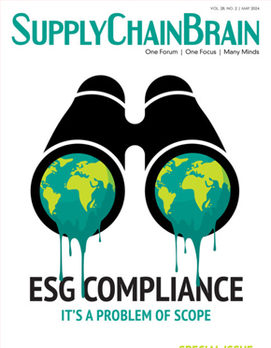
There was a time when companies were responsible only for their direct operations. A CEO might stay up at night worrying about compliance risks in the factories that the company owned, but not about those at the far end of its supply chain churning out raw materials.
That view of the world, however, is changing rapidly.
Governments, investors and consumers are demanding increased visibility into every link of the supply chain, to ensure that corporate funds aren’t inadvertently supporting fundamentally unethical behavior. It’s clear from legal enforcement actions that many companies take a hands-off approach to compliance within their extended supply chains. As a result of this opacity, many major companies have unknowingly — or with willful blindness — contributed to human trafficking and slavery, environmental devastation, and corruption.
By necessity, the veil is coming off. New laws are requiring that companies gain greater supply chain visibility and take responsibility for what’s happening both upstream and downstream along their supply chains, even when suppliers are operating in opaque regions.
In the U.S., the new Uyghur Forced Labor Prevention Law is placing the burden of proof on American importers to demonstrate that goods imported from the Xinjiang region of China, or elsewhere in the country if using Xinjiang-exported labor, aren’t manufactured utilizing forced labor. This is likely to affect a wide range of companies, particularly in the apparel, automotive, food & beverage, technology, and solar sectors. States are also starting to mandate supply chain due diligence and transparency, from the California Transparency in Supply Chains Act to the anticipated New York Fashion Sustainability and Social Accountability Act.
In Europe, a number of countries, such as Germany, France and Norway, are mandating that companies assess their supply chains for human rights and environmental impact, and work to prevent or mitigate issues. There are similar laws in Switzerland, the United Kingdom, the Netherlands and, outside Europe, Australia. Even stronger regulation is on the horizon, with the much anticipated EU Mandatory Due Diligence Directive that will direct all companies operating in the EU to uncover and remediate negative impacts relating to environmental, social and good governance (ESG) factors throughout their supply chains.
These laws come on the heels of statutes in a number of countries, including in the United States, Europe and Asia, that require companies to examine company supply chains for the presence of conflict minerals, adding yet another reason to know where goods come from and how they were produced.
One major obstacle to supply chain visibility is that as business continues to globalize, supply chains are increasingly spread all over the world, often under conditions that make transparency less accessible. China, the supplier of one out of every five goods imported into the U.S. and the largest trading partner of the EU, has a problematic relationship with both human rights and transparency. Gaining reliable insights into whether factory employees in Xinjiang are victims of forced labor, for instance, is difficult when a government minder is present for all employee conversations.
As supply chain disruptions are increasingly unavoidable, it’s worth considering tightening and shortening supply lines with an eye to facilitating greater transparency. The coming trajectory of supply chain visibility legislation in both the U.S. and Europe is clear. Unless companies know and can mitigate what’s happening across their supply chains, they’ll soon be risking massive penalties. The German supply chain law, for instance, allows for fines of up to 2% of a company’s global revenue. It is, therefore, incumbent on business leaders to consider local transparency or opacity norms as a major factor in deciding where to establish supply lines, on par with supplier price and reliability.
This might mean bringing some factories or supply lines back home through onshoring. Alternatively, some experts have advocated the advantages of moving supply lines to reliable rule-of-law countries via a process called ally shoring. Whatever the mechanism, however, companies must have a system in place to see into the intricate business operations of the suppliers on whose goods and services they rely.
Of course, not every company has the luxury of relocating its supply lines or factories. Sometimes, metal and minerals must be mined under the ground where they’re found, even if the governance systems above the ground are imperfect, opaque or corrupt. But problematic political circumstances cannot act as an excuse to blindly acquiesce to unacceptable and unethical business behavior. Indeed, those circumstances can provide an opportunity for companies to improve the lives of workers, the conditions of communities, the state of environments, and policies of governments. Recognizing this fact, the Organization for Economic Co-operation and Development emphasizes the importance of businesses using their tremendous leverage to affect positive change throughout global markets via their supply chains.
Most multinational companies are already engaged in some degree of due diligence efforts on their supply chains, but they must bolster those efforts and elevate a wide range of ESG issues to the forefront of their compliance priorities. Anti-corruption efforts —which already make up a sizable component of the ESG landscape — can provide a useful template for human rights and sustainability compliance.
Supplier questionnaires used in existing due diligence, for example, can be expanded to include questions on forced labor, deforestation, child labor, climate impact and conflict minerals. Similarly, the infrastructure that compliance departments have established should form the foundation of similar ESG inquiries. Investing in such tools now will pay massive dividends later when the supply chain transparency regulatory regime comes into full force.
Companies should also consider how ESG compliance will be handled internally. Will compliance handle all ESG-related matters? Will there be separate C-suite roles for sustainability, diversity and inclusion, and human rights?
It’s time to give thought to organizing your company for success around ESG issues and make your transparent supply chains a point of strength, not an unknown area of risk.
Pia Vining is vice president of Tcompliance.







